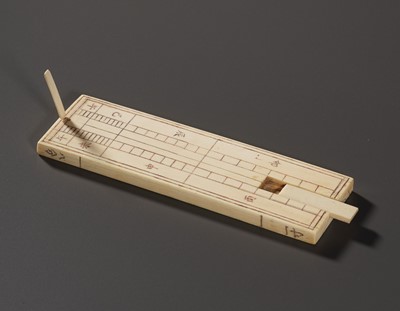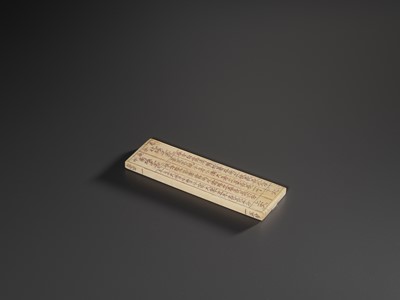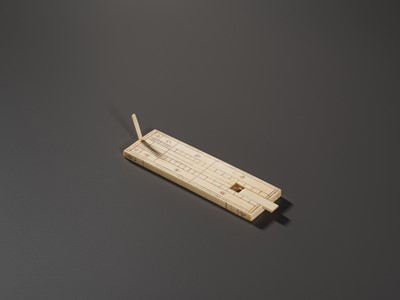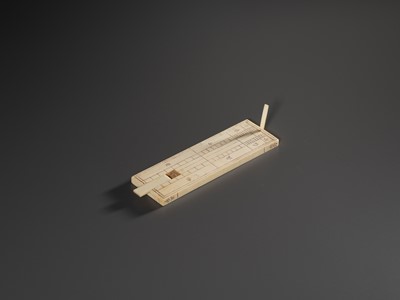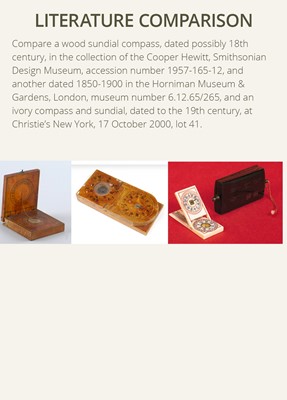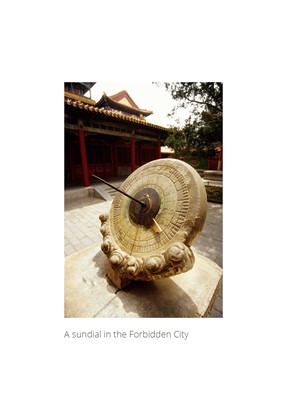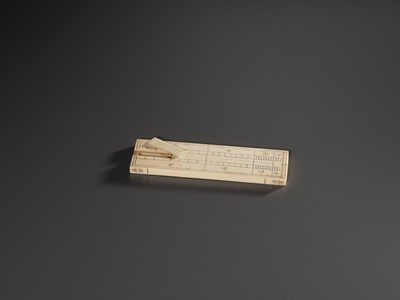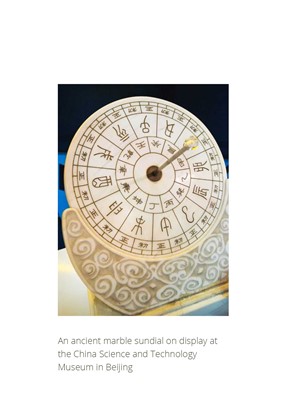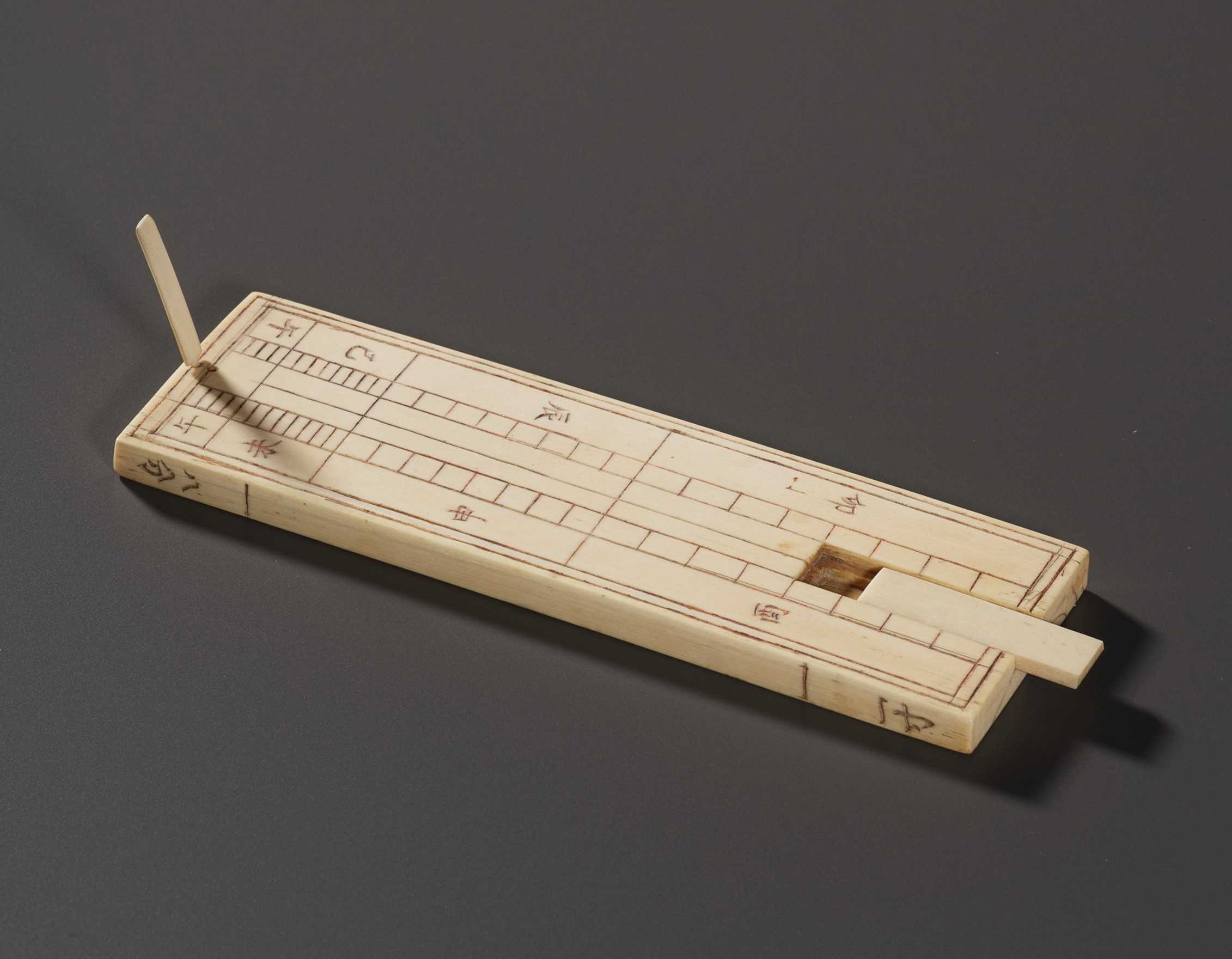30th Sep, 2022 10:00
DAY 2 - TWO-DAY AUCTION - Fine Chinese Art / 中國藝術集珍 / Buddhism & Hinduism
299
Ɏ AN IVORY SUNDIAL, TUGUI, QING DYNASTY
清代象牙日晷
Sold for €2,600
including Buyer's Premium
China, 1644-1912. Of rectangular form, incised with characters to one side indicating time periods and to the other indicating the celestial poles, seasons, and 24 solar terms, along with how long the shadow should be for specific time periods. The top of the sundial is pierced with two small holes to insert the gnomon, which is stored in a small recess at the lower end covered by a small rectangular ivory fitting.
Provenance: From a French private collection.
Condition: Very good condition with minor wear, natural age cracks, few minuscule nicks and light scratches. With a naturally grown, honey-golden patina overall.
Weight: 118.7 g
Dimensions: Length 15.8 cm
Trade Certificate: The trade certificate for the sale of this lot within the EU has been granted (permit number AT 22-B-0074).
Some types of sundials have existed in China since around 800 BC, and these eventually evolved into sophisticated water clocks by circa 1000 AD. Sometime during the Song dynasty, a compass would also be added to the sundial. There is an early reference to sundials from 104 BC, found in an assembly of calendar experts. However, equatorial and polar sundials, as commonly found in Europe and Arabia, did not exist in China until the late Ming dynasty, when Catholic missionaries introduced them to Chinese astronomers.
Literature comparison: Compare a wood sundial compass, dated possibly 18th century, in the collection of the Cooper Hewitt, Smithsonian Design Museum, accession number 1957-165-12, and another dated 1850-1900 in the Horniman Museum & Gardens, London, museum number 6.12.65/265, and an ivory compass and sundial, dated to the 19th century, at Christie’s New York, 17 October 2000, lot 41.
清代象牙日晷
中國, 1644-1912年。 象牙長方形日晷,一面有南北兩極的使用指示和二十四節氣,另一面的移動式陀羅尼上有一個小格子開口,表面刻著交錯時間。 可根據緯度的不同,調節好晷版的坡度仰角,在晷版立一籤板,在晷版投影上,就可以讀出時間,在景版上,就可以讀出節氣來。
來源:法國私人收藏。
品相:品相極好,輕微磨損, 年代裂紋, 一些微小的刻痕和輕微的劃痕。 整體帶有自然生長的蜜色包漿。
重量:118.7 克
尺寸:長 15.8 厘米
象牙交易證書:附有此拍品在歐盟範圍內的交易證書複本(證書編號 AT 22-B-0074)。
西元前 800 年左右,中國有了日晷,最終在西元 1000 年左右演變成複雜的水鐘。 在宋朝時,日晷上也會增加一個指南針。 曾有記錄發現了西元前 104 年的日晷。然而,在歐洲和阿拉伯常見的赤道日晷和極地日晷,直到明朝末年才出現在中國,是當時的天主教傳教士將它們介紹給中國天文學家。
文獻比較:比較一件可能約為十八世紀的木雕日晷,見庫柏休伊特設計博物館,編號1957-165-12。另一件1850-1900年的木雕日晷在倫敦Horniman Museum & Gardensmuseum,編號6.12.65/265。一件十九世紀象牙日晷,見紐約佳士得,2000年10月17日,lot 41。
China, 1644-1912. Of rectangular form, incised with characters to one side indicating time periods and to the other indicating the celestial poles, seasons, and 24 solar terms, along with how long the shadow should be for specific time periods. The top of the sundial is pierced with two small holes to insert the gnomon, which is stored in a small recess at the lower end covered by a small rectangular ivory fitting.
Provenance: From a French private collection.
Condition: Very good condition with minor wear, natural age cracks, few minuscule nicks and light scratches. With a naturally grown, honey-golden patina overall.
Weight: 118.7 g
Dimensions: Length 15.8 cm
Trade Certificate: The trade certificate for the sale of this lot within the EU has been granted (permit number AT 22-B-0074).
Some types of sundials have existed in China since around 800 BC, and these eventually evolved into sophisticated water clocks by circa 1000 AD. Sometime during the Song dynasty, a compass would also be added to the sundial. There is an early reference to sundials from 104 BC, found in an assembly of calendar experts. However, equatorial and polar sundials, as commonly found in Europe and Arabia, did not exist in China until the late Ming dynasty, when Catholic missionaries introduced them to Chinese astronomers.
Literature comparison: Compare a wood sundial compass, dated possibly 18th century, in the collection of the Cooper Hewitt, Smithsonian Design Museum, accession number 1957-165-12, and another dated 1850-1900 in the Horniman Museum & Gardens, London, museum number 6.12.65/265, and an ivory compass and sundial, dated to the 19th century, at Christie’s New York, 17 October 2000, lot 41.
清代象牙日晷
中國, 1644-1912年。 象牙長方形日晷,一面有南北兩極的使用指示和二十四節氣,另一面的移動式陀羅尼上有一個小格子開口,表面刻著交錯時間。 可根據緯度的不同,調節好晷版的坡度仰角,在晷版立一籤板,在晷版投影上,就可以讀出時間,在景版上,就可以讀出節氣來。
來源:法國私人收藏。
品相:品相極好,輕微磨損, 年代裂紋, 一些微小的刻痕和輕微的劃痕。 整體帶有自然生長的蜜色包漿。
重量:118.7 克
尺寸:長 15.8 厘米
象牙交易證書:附有此拍品在歐盟範圍內的交易證書複本(證書編號 AT 22-B-0074)。
西元前 800 年左右,中國有了日晷,最終在西元 1000 年左右演變成複雜的水鐘。 在宋朝時,日晷上也會增加一個指南針。 曾有記錄發現了西元前 104 年的日晷。然而,在歐洲和阿拉伯常見的赤道日晷和極地日晷,直到明朝末年才出現在中國,是當時的天主教傳教士將它們介紹給中國天文學家。
文獻比較:比較一件可能約為十八世紀的木雕日晷,見庫柏休伊特設計博物館,編號1957-165-12。另一件1850-1900年的木雕日晷在倫敦Horniman Museum & Gardensmuseum,編號6.12.65/265。一件十九世紀象牙日晷,見紐約佳士得,2000年10月17日,lot 41。
Zacke Live Online Bidding
Our online bidding platform makes it easier than ever to bid in our auctions! When you bid through our website, you can take advantage of our premium buyer's terms without incurring any additional online bidding surcharges.
To bid live online, you'll need to create an online account. Once your account is created and your identity is verified, you can register to bid in an auction up to 12 hours before the auction begins.
Intended Spend and Bid Limits
When you register to bid in an online auction, you will need to share your intended maximum spending budget for the auction. We will then review your intended spend and set a bid limit for you. Once you have pre-registered for a live online auction, you can see your intended spend and bid limit by going to 'Account Settings' and clicking on 'Live Bidding Registrations'.
Your bid limit will be the maximum amount you can bid during the auction. Your bid limit is for the hammer price and is not affected by the buyer’s premium and VAT. For example, if you have a bid limit of €1,000 and place two winning bids for €300 and €200, then you will only be able to bid €500 for the rest of the auction. If you try to place a bid that is higher than €500, you will not be able to do so.
Online Absentee and Telephone Bids
You can now leave absentee and telephone bids on our website!
Absentee Bidding
Once you've created an account and your identity is verified, you can leave your absentee bid directly on the lot page. We will contact you when your bids have been confirmed.
Telephone Bidding
Once you've created an account and your identity is verified, you can leave telephone bids online. We will contact you when your bids have been confirmed.
Classic Absentee and Telephone Bidding Form
You can still submit absentee and telephone bids by email or fax if you prefer. Simply fill out the Absentee Bidding/Telephone bidding form and return it to us by email at office@zacke.at or by fax at +43 (1) 532 04 52 20. You can download the PDF from our Upcoming Auctions page.
How-To Guides
How to Create Your Personal Zacke Account
How to Register to Bid on Zacke Live
How to Leave Absentee Bids Online
How to Leave Telephone Bids Online
中文版本的操作指南
创建新账号
注册Zacke Live在线直播竞拍(免平台费)
缺席投标和电话投标
Third-Party Bidding
We partner with best-in-class third-party partners to make it easy for you to bid online in the channel of your choice. Please note that if you bid with one of our third-party online partners, then there will be a live bidding surcharge on top of your final purchase price. You can find all of our fees here. Here's a full list of our third-party partners:
- 51 Bid Live
- EpaiLive
- ArtFoxLive
- Invaluable
- LiveAuctioneers
- the-saleroom
- lot-tissimo
- Drouot
Please note that we place different auctions on different platforms. For example, in general, we only place Chinese art auctions on 51 Bid Live.
Bidding in Person
You must register to bid in person and will be assigned a paddle at the auction. Please contact us at office@zacke.at or +43 (1) 532 04 52 for the latest local health and safety guidelines.
